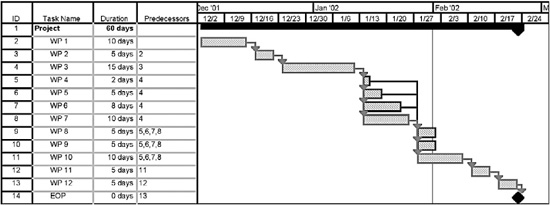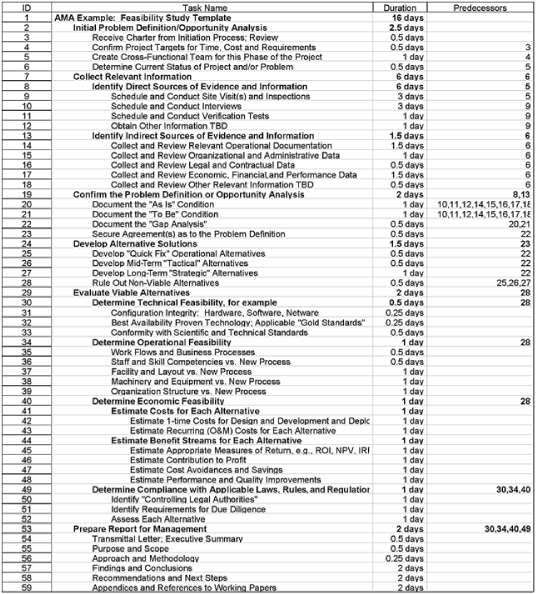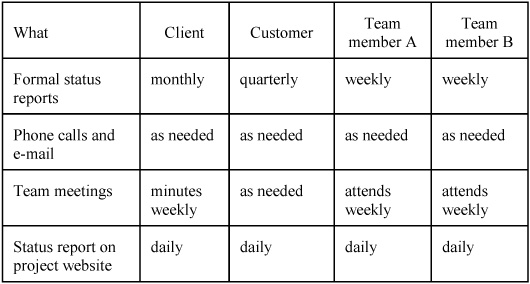CHAPTER 9
Compiling the Major Components of a Project Plan
IN CHAPTERS 1 THROUGH 8, you completed several steps related to project initiation and planning. You collected requirements, defined project scope, created a work breakdown structure, defined and sequenced activities, and estimated activities. You are now ready to compile all this information into an integrated project plan, communicate it to others, and secure necessary commitments and approvals. The final result of the planning process is a management decision on whether to proceed with the execution of the project.
This chapter outlines the major components of a typical project plan. Your management may require additional items. Some executives require a formal risk management component; others look for detailed financial analyses. Some executives look for acceptance-test plans, and others look for explicit linkages between technology and organizational goals. Still others want written opinions from legal counsel, authorizations and permits from regulatory bodies or clients, and so on.
Before you submit your complete project plan, review it carefully with your planning team and get the necessary commitments from resource owners to provide the staff and other resources you will need in the specified number, skill level, mix, timing, and place.
The planning process ends when the integrated plan obtains the authorization to proceed to execute the project. Senior managers authorize performance of the work (along with approvals from customers, clients, and end users, as the case demands) and agree to provide the project manager and the team with the fiscal, physical, and intellectual resources needed for the project.
Project Charter
The project charter defines the purpose and rationale of the project. It describes, at a fairly high level, the results to be achieved, the products and services to be delivered, and the links between your goals and the broader goals of the enterprise. This document may also be called a business case.
Project Scope Statement
The project scope statement formally documents what the project will and will not produce. It defines your project, including objectives, specifications, exclusions, constraints, risks, and assumptions. It defines the parameters of time, cost, and scope.
Schedule Plan
The project schedule shows the anticipated duration for each activity (work package) and the start and end dates for each. The schedule plan also shows the roll-up of all work items to indicate total duration and the scheduled completion date for the project. The schedule plan must also reflect the logical dependencies among work packages so that the sequence of work can be understood and displayed.
The schedule plan shows all the activities (work packages) with estimates for time and sequence. You can build your schedule plan using these three elements:
1. Work package descriptions from the work breakdown structure (see Chapter 4)
2. Dependency relationships from the network diagram (see Chapter 5)
3. Duration estimates (see Chapter 6)
You can display your project’s schedule in various ways. While the precedence network diagram is the most useful tool for determining the sequence of activities and setting the initial schedule, Gantt charts are often used to communicate information about activities. A Gantt chart is a bar chart that shows activities on a scaled timeline, with their durations shown as bars overlaid on the appropriate dates. Arrows on the Gantt chart show dependencies between the activities. Figure 9-1 shows a generic critical path bar chart. The information in this chart could also be presented as a table (see Figure 9-2). A more complex example of project schedule information, using the example introduced in Figure 8-4, appears in Figure 9-3.
Figure 9-1 Illustrative Critical Path Bar Chart.

Figure 9-2 Project Schedule as a Table.

Figure 9-3 Project Work Breakdown Structure (with Durations and Dependencies).

Resource Utilization Plan
The resource utilization plan displays the distribution of people, equipment, material, supplies, and other assets. Ideally, this distribution is tied to specific activities and not just at the top levels in the work breakdown structure.
Budget Plan
The cost plan or budget is the financial expression of the work breakdown structure. The cost plan or budget depicts the costs likely to be committed, accrued, or obligated by work package for each interval in the schedule. In some organizations, the cost plan is balanced against a revenue projection plan to calculate net cash flows for the performing organization. Each organization has its own forms and procedures for displaying and analyzing project cost information.
Milestone Plan
The milestone plan indicates the key deliverables that arise during the life of the project, their due dates, the organization or department responsible for producing them, and the organization or department expecting their receipt as a condition of starting its own work.
Organization Plan
The project’s organization plan clarifies the relationships between departments (sometimes called the organizational breakdown structure) and the work items established in the work breakdown structure. The purpose of the organization plan is to ensure that every work package has an owner or a champion, that no activity is orphaned, and that complex and subtle relationships among players are well understood.
One method is to use a spreadsheet to assign work packages (activities) to organizational units. These units may be internal or external to the performing organization. This allows you to establish with care what outside vendors or third parties own the project. The cells define the relationship that each organizational unit has to each work package. One scheme to define these relationships uses the following nomenclature:
A—directly performs the work; is answerable for the quality of the end item
B—reviews work to determine adherence to quality standards
C—has the authority to approve intermediate deliverables
D—must be consulted prior to a decision; mandatory input
E—may be consulted prior to a decision
F—must be notified after a decision is made
X—may exercise veto power regarding a specific work product
O—may override the veto
Risk Management Plan
A risk is an “uncertain event or condition that, if it occurs, has an effect on at least one project objective” (scope, schedule, or budget). (See A Guide to the Project Management Body of Knowledge (PMBOK® Guide), p. 275. The risk management plan, evolving throughout the planning process, incorporates (1) risk identification; (2) qualitative and quantitative assessments; (3) strategies for prevention, detection, and mitigation of loss; and (4) recovery and restoration of functions. (See Chapter 13 for more information about managing risk.)
Communication Plan
The communication plan describes how the project manager will keep information flowing during the project. This plan should describe meetings and reports as well as the frequency and content of reports sent to senior management, stakeholders, and the client. It should also describe the frequency and agenda for regular and exception meetings, such as team status meetings and senior management project reviews. You may wish to use a communication matrix like the one shown in Figure 9-4.

